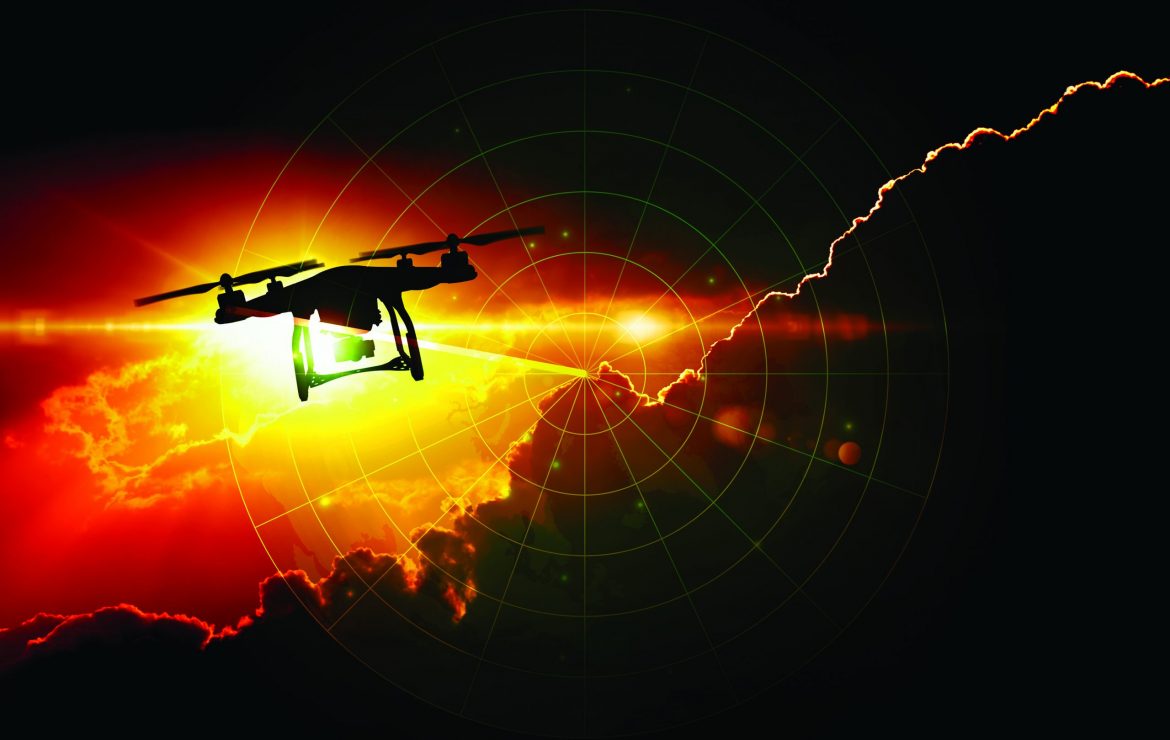Drones are posing an increasing threat in the battlefield as well as a threat to airports, sports stadiums, government buildings and urban areas, therefore many companies have invested in developing anti-drone systems, as this market is expected to increase from the current $2 billion dollars to $6.6B billion by 2024. However, the currently developed systems are not totally capable of countering these threats, thus, a rising number of countries are deploying several detection and interdiction techniques.
Once the preserve of the most well-resourced power, Unmanned Aerial Vehicles (UAVs) or drones have become increasingly prevalent in many areas of life, and are used by an increasingly wide variety of actors. At one end of the spectrum, the large and deadly systems such as Predator UAVs and their associated missile systems remain very expensive and sophisticated. However, the proliferation of technology and illicit support for militant and terrorist groups means such capability is spreading. On the other end of the spectrum, cheap and easily obtained small commercial drones are becoming very readily available in most localities.
While there are obviously tremendous advantages of the development of such technology, from defensive surveillance to media and logistics applications, UAVs also pose considerable threats in a number of areas. These include hostile surveillance, the movement of smuggled goods, low-sophistication terrorist attacks and general disruption. At this end of the technology spectrum, drones are small, fast, readily available in most department stores for low cost, and difficult to detect and differentiate from legitimate UAVs.
In terms of business opportunity, drones offer tremendous potential and are already expanding into a number of areas of daily life, from imagery and media at major sporting events, to the delivery of small goods to households. The nefarious applications of drones, however, are also offering important business opportunities for those who can develop failsafe and reliable counter-UAV systems. The stakes are high: the three-day disruption of passenger air traffic by small drones at London’s Gatwick airport in December 2018, for example, is estimated to have cost some airlines up to £15 million in lost revenue. Some estimates suggest the counter-UAV market has already passed $1 billion in value at the time of writing, and is likely to expand much further.
Techniques for countering the threat: detection and interdiction
The challenge of countering the UAV threat can be considered broadly across two approaches and techniques: detection, and interdiction. In both categories, a number of systems are starting to emerge and are starting to show the way for the industry. In some cases, detecting hostile drones and steering away from them will be enough to deliver security, while in other cases, systems to promptly take such drones out of the sky will be essential. At the same time, both approaches are interlinked, in the sense that effective mechanisms to remove hostile drones from the sky rely on effective approaches for detecting the drone in the first place and differentiating it from a friendly or legitimate drone.
Detection approaches
Systems for detecting hostile UAVs primarily revolve around a variety of measures in which electronic signals are collected and monitored. Particularly in the case of low-flying, small drones, traditional large-scale air defence and radar systems are not always very effective at spotting the hostile UAV in question. With that said, newer radar systems aimed at detecting low-altitude radio frequencies (RF) form the basis of many counter-UAV systems. RF can also be used in a detection approach if the hostile drone is emitting data on known frequencies, which can be monitored.
In other systems, heat signatures using infrared detection technology; or audio or visual signatures using arrays of sensitive microphones or optical sensors, whose collected data is analysed using algorithms and direction-finding triangulation, can help to identify and differentiate hostile UAVs.
Successful detection of hostile UAVs can allow for evasive action to be taken, even if the UAV in question cannot be readily interdicted. There is pressure on drone manufacturers to help by agreeing standard RFs and electronic identifiers which can be readily identified. The Chinese AeroScope system, for example, offers an electronic ID platform for identifying and monitoring commercial drones using known identifiers. Other more comprehensive approaches include DARPA’s Aerial Dragnet system. While developed primarily for a military context, the Dragnet concept of a network of tethered drones monitoring RFs in specific localities could be a solution for civilian environments. Despite these developments, some manufacturers are reluctant to surrender too much detail that could be commercially sensitive and beneficial for competitors.
The difficulty for detection systems, especially in the domain of smaller and lower-altitude UAVs is the effectiveness of differentiating to high levels of confidence such drones from legitimate systems, or even from birds in some cases.
This can obviously be a particular problem if interdiction is then undertaken against the wrong targets. At the more sophisticated end of the spectrum, UAVs may use complex encryption or stealth technology which can mean that electronic signatures are difficult to identify, or are obfuscated. In all cases, some drones may operate largely autonomously when in flight and not emit much in the way of RF for long periods. Generally, it appears that there is not yet a system on the market that can offer anything approaching full effectiveness in accurately identifying hostile UAVs at any level.
Interdiction approaches
Interdiction involves a range of kinetic and electronic methods for disabling a drone or taking it out of the sky altogether. A number of different approaches are being trialled, and many can be used in combination with one another.
The traditional approach to intercepting and disabling hostile aerial vehicles is to use surface-to-air (SAM) or air-to-air (AAM) missiles. Many of these military systems are designed to spot and interdict larger and faster vehicles than is often the case with UAVs, and, as such, are not always very accurate to the levels required for successful interdiction. It is also the case that missile defence systems such as the Patriot or Russian S-series systems are very expensive to deploy, and disproportionately so when attempting to interdict a relatively minor UAV threat. Nevertheless, recent incidents such as the missile and drone attack against civilian or military institutions have highlighted the weakness of counter-UAV systems such as Patriot against low-altitude and small drones.
As with detection systems, many interdiction systems focus on disabling or disrupting (“jamming”) RF frequencies from drones, thus either causing them to crash or disrupting their flight. GPS “spoofers” can trick a drone into misreading its location and thus be steered away from danger. Electro-Magnetic Pulse (EMP) systems fire high-frequency microwave signals at drones, disrupting or in some cases destroying their electronic components.
As with detection systems, however, such methods can be unreliable in accurately differentiating hostile from legitimate drones in the area. In some cases, inadvertently jamming too many drones in an area, disrupting legitimate drones, or causing risk to public safety through the inadvertent jamming of air traffic control, passenger aircraft, or civilian cellphone systems, mean that work is still required on improving the accuracy of jamming methods in many environments.
Other systems, especially in more civilian environments, have experimented with a range of nets, laser beams, high-velocity water jets, “sacrificial collision” with deployed small drones and even well-trained birds of prey (as used by Dutch police among others). All of these have benefits in some cases, primarily against smaller and slower-moving drones, but they also have their difficulties.
The use of any kinetic method for interdicting drones can introduce safety concerns in built-up or busy areas. The risks can include accidentally disrupting or hitting legitimate air traffic, or the risk of injury on the ground when a stricken drone drops from the sky. Some of the net systems have attempted to mitigate this with parachutes to allow for a graceful return to earth, such as UK company OpenWorks’s shoulder-mounted net launcher, which uses compressed air to fire a drone-capturing net up to 100 metres away.
There may also be legal and regulatory issues with using kinetic interdiction methods in built-up environments, such as questions over the rights of private companies to use such methods in public scenarios, and insurance complications where private property is damaged or destroyed, or where public safety is compromised. In many cases, such concerns are only just starting to be realised with the rapid rise of the use of small drones in urban environments.
In general terms, a range of approaches which integrate detection and interdiction, and which use different mechanisms in combination, are likely to be the favoured path for many organisations looking for effective and reliable counter-UAV capabilities. Many of these systems are expensive; do not always deliver high rates of reliability; and their use in crowded, civilian environments are posing considerable regulatory questions. But the damage that can be done by a well-aimed UAV, whether in physical, reputational or cost terms, will be increasingly severe for many organisations in such areas as critical national infrastructure. There will be growing merit in investing in some of the emerging defensive systems on offer.
» By: Prof. Ju lian Richards
(Centre for Security and Intelligence Studies (BUCSIS), University of Buckingham, UK)













